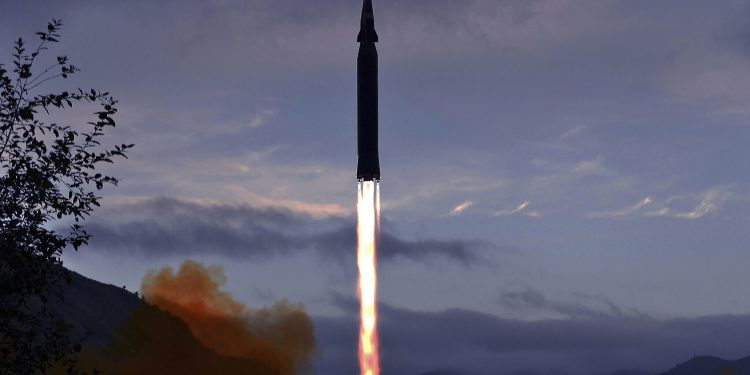North Korea fired an intercontinental ballistic missile Friday in one of its most powerful tests ever, with Japan saying the weapon may have had the range to hit the United States mainland.
The missile was believed to have landed in Japan’s exclusive economic zone (EEZ), Prime Minister Fumio Kishida said as he blasted the launch as “absolutely unacceptable”.
The launch is Pyongyang’s second in two days and part of a record-breaking blitz in recent weeks, which North Korea — and some allies including Moscow — blame on the US boosting regional security cooperation, including joint military exercises.
The missile flew 1,000 km (621 miles) at an altitude of 6,100 km, South Korea’s military said, only slightly less than the ICBM Pyongyang fired on March 24, which appeared to be the North’s most powerful such test yet.
Later on Friday, Tokyo and Washington held joint military drills in the airspace over the Sea of Japan.
“Japan Self-Defense Forces and US armed forces conducted a bilateral exercise… amid an increasingly severe security environment surrounding Japan,” a joint staff statement distributed by the Japanese defence ministry said.
“This bilateral exercise reaffirms the strong will between Japan and the United States to respond to any situation.”
US Vice President Kamala Harris convened a meeting on the sidelines of an Asia-Pacific summit in Bangkok to discuss the launch with regional leaders.
“We strongly condemn these actions and we again call for North Korea to stop further unlawful, destabilizing acts,” Harris said.
North Korea, led by Kim Jong Un, has fired scores of ballistic missiles this year — far more than any other year on record — and recent launches have been increasingly provocative, including firing a missile over Japan last month, triggering a rare air-raid warning.
On November 2, Pyongyang fired 23 missiles, including one which crossed the de facto maritime border and landed near the South’s territorial waters for the first time since the end of hostilities in the Korean War in 1953. Seoul called it “effectively a territorial invasion”.
The next day, North Korea fired an ICBM — although Seoul said it appeared to fail mid-flight.
Friday’s ICBM was fired at a “lofted trajectory”, Tokyo’s Defence Minister Yasukazu Hamada said, meaning the missile is fired up and not out, typically to avoid overflying neighbouring countries.
He said their calculations indicated that the missile “could have had a range capability of 15,000 km, depending on the weight of its warhead, and if that’s the case, it means the US mainland was within its range”.
The launch comes a day after North Korea fired a short-range ballistic missile in what Pyongyang said was a response to Sunday’s talks between Seoul, Tokyo and Washington.
The North’s foreign minister, Choe Son Hui, had warned that Pyongyang would take “fiercer” military action if the US followed through on plans to strengthen its “extended deterrence” commitment to regional allies.
‘A clear message’
In addition to speaking to Seoul and Tokyo’s leaders, US President Joe Biden discussed North Korea’s recent missile tests with Chinese counterpart Xi Jinping earlier this week, as fears grow that the reclusive regime will soon carry out its seventh nuclear test.
The launches are “a clear message to the US and Japan”, said Han Kwon-hee, manager of the Missile Strategy Forum, adding the launches were “part of the North’s response to recent talks”.
Pyongyang is trying to show the South and America that its “missiles can easily break through their defence systems, no matter how much the two try to improve them”, Han added.
Washington has responded to North Korea’s sanction-defying missile tests by extending exercises with South Korea, including deploying a strategic bomber, and by moving to boost the protection it offers Seoul and Tokyo.
China, Pyongyang’s main diplomatic and economic ally, joined Russia in May in vetoing a US-led bid at the UN Security Council to tighten sanctions on North Korea.
Experts say North Korea is seizing the opportunity to conduct banned missile tests, confident of escaping further UN sanctions due to Ukraine-linked gridlock at the United Nations.
“I primarily see these types of lofted ICBM tests as having a developmental purpose,” said Ankit Panda, Stanton senior fellow at the Carnegie Endowment for International Peace.
“Kim will test a nuclear weapon at a time of his choosing. North Korea can carry out such a test with little notice.”











